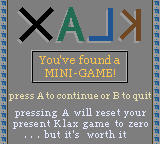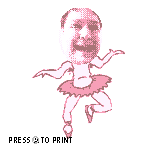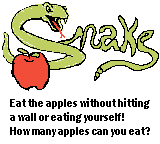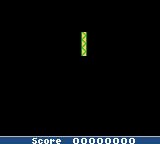Klax (Game Boy Color)
| Klax |
|---|
|
Developer: Digital Eclipse
|
Today, it is the Millennium, and thanks to the power of Nintendo's Game Boy Color, you can now take Klax with you anywhere you go!
Contents
Hidden Printer Feature
The feature is accessed by selecting green alien, green alien, red circle, blue square. After skipping the found minigame page, a picture of a head attached to a body will display with an option to print. The heads can be selected with the D-Pad.
Hidden Messages
A series of hidden messages can be accessed by selecting green diamond, blue pillar, blue pillar, green alien ten times.
Marriage Proposal
Select red circle, blue pillar, blue pillar, blue square ten times. At first, it will jump to the title screen, but after ten times, a screen will pop up saying that you found a minigame. After proceeding, a photo made on the Game Boy Camera of the programmer (Mike Mika) and his fiancee (Micki) will pop up, with the words
Micki, will you Marry me?
Fictional History
Select blue square, blue pillar, green diamond, green alien in order to access this. Once again, the screen will say that you've found a minigame. After proceeding, a very long fictional backstory about Klax will appear that says
The Story of Klax
Klax, or
"Klacksing," as it
was originally
known, began on the
boardwalks of sea-
side resort towns
in New Jersey, and
quickly spread up
and down the Eastern
Seaboard. Although
some trace its roots
back to the Colonial
days, it is far more
likely that it
started during the
heady days of the
"Gilded Age,"
roughly 1870 - 1899.
Gameplay was
remarkably similar
to the way the game
is played today.
A conveyor belt (the
first models were
cranked by young
urchins, but these
were quickly
replaced by steam or
electric engines)
carried large wooden
tiles towards a
depression in the
ground, called a
well. The tiles were
place on the
conveyor behind a
curtain. Because the
tiles were arranged
in a well, the
person placing the
tiles couldn't see
what patterns were
being chosen, and so
what colors came
down the conveyor
was theoretically
random.
The gentleman
(ladies were not
allowed to play) who
was "klacksing" then
arranged the tiles,
as we do today, in
vertical or
horizontal rows of
like colors
(diagonals were not
introduced until the
mid-1930s), under
the watchful eye of
the game minder, who
mad sure that the
players did not
surreptitiously
rearrange tiles. In
the early days,
players were limited
to the tiles they
could hold in their
hands, and if three
tiles dropped off
the conveyor, the
game was over. If
the player achieved
an objective,
(getting 4
"klackses" or 3 in a
row, say) that was
previously agreed
upon between him and
the game minder, he
won a small prize,
like a Kewpie Doll.
Better prizes were
awarded for more
difficult
arrangements.
Although
Klacksing was a
popular resort
pastime, it really
took off during the
Roaring 20s, when
the "shoe" was
introduced. The shoe
was a device that
held up to five
tiles--no longer
were players limited
to the tiles they
held in their hand.
The shoe was also a
convenient place to
stash contraband
bottles of beer if
the Police happened
by. The word for the
practice, "shoeing",
quickly became slang
for hiding alcohol,
and Klax (as it was
re-christened in
Pepe Morano's famous
song of the era),
which was once
considering a
sporting game for
proper Victorian
gentlemen, quickly
became associated
with pool halls,
bootlegging, and
fast living.
Even the Great
Depression couldn't
dull enthusiasm for
Klax, in fact, with
the diagonal, Klax
became more popular,
and the subject of
more decency
crusades aiming to
eliminate it. The
introduction of the
diagonal Klax was
made possible when
fully electro-
mechanical versions
of the game, which
used magnetized
tiles and mercury
switches to sense
klaxes, were shipped
from the arcade
makers in Chicago
across the country.
It certainly didn't
help the game's
reputation to have
most versions
stamped with the
name of the Windy
City, which was then
associated with Al
Capone and all
things criminal.
Despite the
decency crusader's
efforts, it event-
ually took a war to
quell the popularity
of Klax. Because the
electromechanical
game used so much
precious metal, and
because the game
took so much time
away from boys who
were soon to be
occupied by more
treacherous tasks,
F.D.R. banned the
game in an executive
order dated February
2nd, 1942.
"It is the war, and
there is no time for
Klax," declared FDR
in a public
statement, April
3rd, 1942. With most
players--and
operators--destined
for the Army, there
was no public outcry
about the ban, and
after the war, the
game was quickly
forgotten in the
wave of post-war
technological
achievements like
television and
Skee-Ball. A few
newspaper columnists
noted Klax's
passing, but the
public at large,
which was so taken
with the game just a
few years ago,
seemed to completely
forget the game,
just as many pre-war
traditions were
lost. The game dis-
appeared so rapidly
from the national
consciousness that
the ban on Klax
wasn't even offic-
ally lifted until
September 8th, 1978,
by Jimmy Carter--the
last of the World
War II executive
orders to be
repealed.
Although a few
electro - mechanical
Klax games exist in
collectors' hands,
the game was largely
forgotten until 1989
when programmers and
designers at Atari
Games resurrected
the concept for a
radical new puzzle
game. The intro
screen,
"It is the 90's and
there is time for
Klax", recalled
FDR's famous
pronouncement.
Today, it is
the Millennium, and
thanks to the power
of Nintendo's Game
Boy, you can now
take Klax with you
anywhere you go!
Real History
Select yellow alien, blue pillar, blue pillar, green alien. You'll see the found minigame screen, and after proceeding, the history of the arcade version is accessed, and it says
THE STORY OF KLAX by David Akers Mark Pierce came up with the idea for the game. He knew he wanted to do a puzzle game, so he started drawing pictures that "looked like" puzzle games - pictures filled with simple, colorful shapes and objects. The best pictures he printed and hung up in his office. After living with these pictures for awhile, he came up with an idea for a puzzle game where tiles tumble down a ramp, and the player catches the tiles and places them in bins to make "three in a row" combinations. Mark wanted the tiles to make a "Click-clack" sound as they moved down the ramp, so we decided to call this game "Klax". The "Klax concept approval" meeting was held on a Friday, and the project was approved, so that weekend I started playing around in Amiga Basic to try and come up with a scoring routine for the game. I created a set of bins, and randomly filled them with tiles, and then wrote the code to score any "Klaxes" (three in a row combinations) that came up. But it was hard to test different combinations with just random tiles, so I added a paddle, and had tiles appear on it so I could drop them where ever I wanted. Then, I added a ramp, and had tiles randomly appear in the different lanes of the ramp, and move down the ramp - so by the end of the weekend I had a crude version of Klax running in Amiga Basic. I showed the Amiga Basic Klax to Mark Pierce, and he made a few suggestions. Then he generated a set of graphics and went on vacation for three weeks. While he was gone, I got a version of Klax running on an old "Escape From the Planet of the Robot Monsters" arcade hardware. By the time Mark got back, people were lining up in the lab to play Klax. At first, the game would just drop tiles, and get faster and faster until the player made a mistake. But we liked the wave structure of the arcade version of Tetris, so we wanted to have waves in Klax. We weren't sure what the "goal" of a Klax wave should be - to make klaxes, or to get some number of tiles, etc. Since people were coming to the lab all day to play the game, we put in a variety of different goals, and changed the goal with every wave, and we asked players which goal they liked best. They said "we like having variety!" so we kept it that way. Originally the tiles were so large that the five bins across filled the screen. But marketing said they wanted two players to be able to play at the same time, so we had to shrink the tiles. Mark still prefers the original "large tile" version. The circuit board used in the arcade version of Klax was a simplified version of the "Escape" board. To reduce cost we had to choose between having a music (FM synthesis) chip and a digitized sample chip. We decided to go with the digitized samples. The audio department experimented with a variety of sounds to get a distinctive sound for each tile. Mark wanted a "golf crowd" effect for winning and losing the rounds, so we gathered all the Atari employees we could find and crammed them into Atari's sound room, and the resulting "Klax Choir" made the different crowd effects.
Credits
The credits can be accessed by selecting blue pillar, yellow alien, green diamond, green diamond and are
for Digital Eclipse Programmer Mike Mika Support Programmers Bob Baffy Support Programmers Joe Miguel Support Programmers Jeremy Mika Project Leader Chris Charla Artists Boyd Burggrabe Artists Kevin James Sound Bob Baffy Producer Bill Schmitt Executive Producer Andrew Ayres Special Thanks David Akers Special Thanks Dan Filner Special Thanks Jeff Frohwein Special Thanks Mark Pierce Special Thanks Jeff Vavasour for Atari Producers Robert Daly Producers Mike Kruse Executive Producer Bill Hindorff Test Manager David Ortiz Product Analysts Larry Cadelina Product Analysts Mario Guevara Product Analysts Jose Amparan Product Analysts Pablo Buitrago Lead Testers Alex Beran Lead Testers Jeffery Suarez Special Thanks Debra Heinz Special Thanks Maribel Santa Cruz THE END
Minigames
Fürd Herder
Select green alien, green alien, blue square, green alien and the game will be accessed after skipping the found minigame screen. The game is a minesweeper clone.
Snake
The game can be accessed by selecting red circle, green diamond, blue square, green alien.
The Klax series
| |
|---|---|
| Arcade | Klax (Prototypes) |
| NES | Klax |
| TurboGrafx-16 | Klax |
| DOS | Klax |
| Game Boy (Color) | Klax (monochrome, Hudson) • Klax (color) |
| Game Gear | Klax |
| Atari ST | Klax |
| Game Boy Advance | Marble Madness & Klax |
- Pages missing developer references
- Games developed by Digital Eclipse
- Pages missing publisher references
- Games published by Midway Games
- Game Boy Color games
- Pages missing date references
- Games released in 1999
- Games released in April
- Games with hidden developer messages
- Games with hidden developer credits
- Games with unused game types
- Games with hidden bonus content
- Klax series
Cleanup > Pages missing date references
Cleanup > Pages missing developer references
Cleanup > Pages missing publisher references
Games > Games by content > Games with hidden bonus content
Games > Games by content > Games with hidden developer credits
Games > Games by content > Games with hidden developer messages
Games > Games by content > Games with unused game types
Games > Games by developer > Games developed by Atari, SA > Games developed by Digital Eclipse
Games > Games by platform
Games > Games by publisher
Games > Games by publisher > Games published by Warner Bros. Games > Games published by Midway Games
Games > Games by release date > Games released in 1999
Games > Games by release date > Games released in April
Games > Games by series > Klax series
The Cutting Room Floor > Unimportant Awards > Game Boy games > Game Boy Color games






